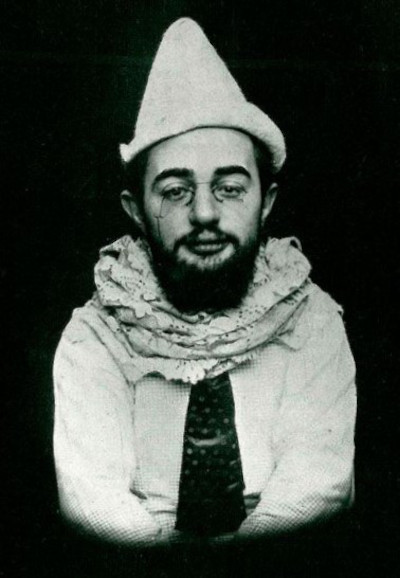Henri de Toulouse-Lautrec was a French painter, draughtsman, caricaturist, printmaker and illustrator. His immersion in Paris colourful and theatrical life in the late nineteenth century allowed him to create a collection of attractive, elegant and interesting images of the modern, at times decadent, the affairs of that period.
Lautrec is one of the popular artists of the Post-Impressionist era, with Paul Gauguin, Vincent van Gogh and Paul Cézanne and this extensive biography looks more deeply into the rise of this great artist.
Early Years
Lautrec was born on 24 November 1864 at the mansion house called Hôtel du Bosc, located in Albi, France. After his younger brother died, Lautrec's mother and father separated and a nanny took care of him. When he turned eight, Lautrec went to Paris to live with his mother, where he started drawing caricatures and sketches in his exercise workbooks. His family quickly realised that Lautrec's talents lay in painting and drawing. René Princeteau, who was his father's friends, visited occasionally to give the young boy informal lessons. Some of the paintings Lautrec produced are of horses, which is Princeteau's speciality, and a subject that he revisited in his famed "Circus Paintings".
His mother was concerned about his health and Lautrec went back to Albi in 1875. He took thermal baths and his mother consulted doctors to find a way to improve Lautrec's growth and development. When he was 13 years old, he fractured his right femur; he fractured his left femur when he was 14 years old. The breaks didn't heal properly. According to modern physicians, this was caused by an unknown genetic disorder, probably pycnodysostosis or a type of disorder that falls along the lines of marble bone disease, osteogenesis imperfecta or achondroplasia. Afterwards, the legs of Lautrec stopped growing, and he remained 4 feet, 8 inches as an adult. He developed a torso the size of an adult and retained his child-sized legs.
Physically unable to take part in most of the activities that males of his age enjoy, he immersed himself in art. Lautrec became an important lithographer, art nouveau illustrator and Post-Impressionist painter, and through his work, he managed to record numerous details of bohemian lifestyle in Paris during the late nineteenth century. During the mid-1890s, he contributed several illustrations to Le Rire, a successful French humour magazine. He passed his 2nd attempt of college entrance exam and completed his studies.
The Bohemian Lifestyle
In 1884, Lautrec went to live in Montmartre, an area in Paris recognised for its bohemian life, including brothels, bars and live musical performances. Lautrec created art to accompany Bruant's music. Bruant was a singer, composer and owner of a cabaret where Lautrec got the opportunity to showcase his pieces. He managed to build a stellar reputation with depictions of celebrities and regular Montmartre denizens that he created. Some of the most prominent subjects by this artist include Loïe Fuller, Jane Avril and Yvette Guilbert.
He created works on canvas but chose to display them in the medium of posters, which made him a highly sought after painter because of his unique style. Toulouse-Lautrec was influenced by Woodblock printing in Japan, a technique that uses the Japanese ukiyo-e artistic style of single sheets. He was also influenced by Edgar Degas, who was an Impressionist and artist.
Paintings, Depictions of Women by Toulouse-Lautrec
Some of the most well-known works by Toulouse-Lautrec include the At the Moulin Rouge (an oil-on-canvas painting depicting Lautrec in a group mix) as well as Rousse, a painting that shows a beautiful woman in a café. Unlike most of his contemporaries, Toulouse-Lautrec was known for his realistic, humanistic depictions of women, avoiding fantasy to reflect the circumstances of most of the people that he met.
Also, many of the pieces he produced captured sex workers while in moments exceeding erotic objectification. This seen in his famed Elles (brothel series of prints executed in 1896) and Woman Before a Mirror (a painting that he produced in 1897). He presents the woman neither as a romantic heroine nor as a moralising symbol, but as a physical, living being with emotions like anyone. The honesty and directness of his paintings testify to the artist's love of women.
Death and Legacy
Though he presented himself as a brilliant, fun person about town, Lautrec suffered greatly because of his physical ailments and past family trauma. His father never accepted the decision he made in becoming a professional artist. Lautrec contacted syphilis from a sex worker called Rosa La Rouge, which further affected his health. He turned to alcohol as a means of dealing with the pain he was going through.
By February 1899, Lautrec's alcoholism started to take its toll; he collapsed from the effects of alcoholism and exhaustion. His family had Lautrec committed to a sanatorium located in Neuilly-sur-Seine for 3 months, where he drew thirty-nine circus portraits. He died at the age of 36 on 6 September 1901 and left behind over 700 canvas paintings, 5,000 drawings, 350 prints and posters, among other works. As a result, Toulouse-Lautrec is considered a seminal pioneer to several movements, such as the pop art world. He's also an early forerunner to icons such as Andy Warhol, who came later.
After Lautrec's death, his art dealer Maurice Joyant and his mother continued promoting his artwork. Toulouse-Lautrec's mother contributed funds and a museum was built in Albi to show his works. The art museum is called Musée Toulouse-Lautrec and has the largest collection of the artist's works. In 2005, an auction was held at La Blanchisseuse, Christie's auction house, and Toulouse-Lautrec's early portrait of a young laundress was sold for 22.4 million dollars, setting a new record for Lautrec's paintings sold at an auction.




